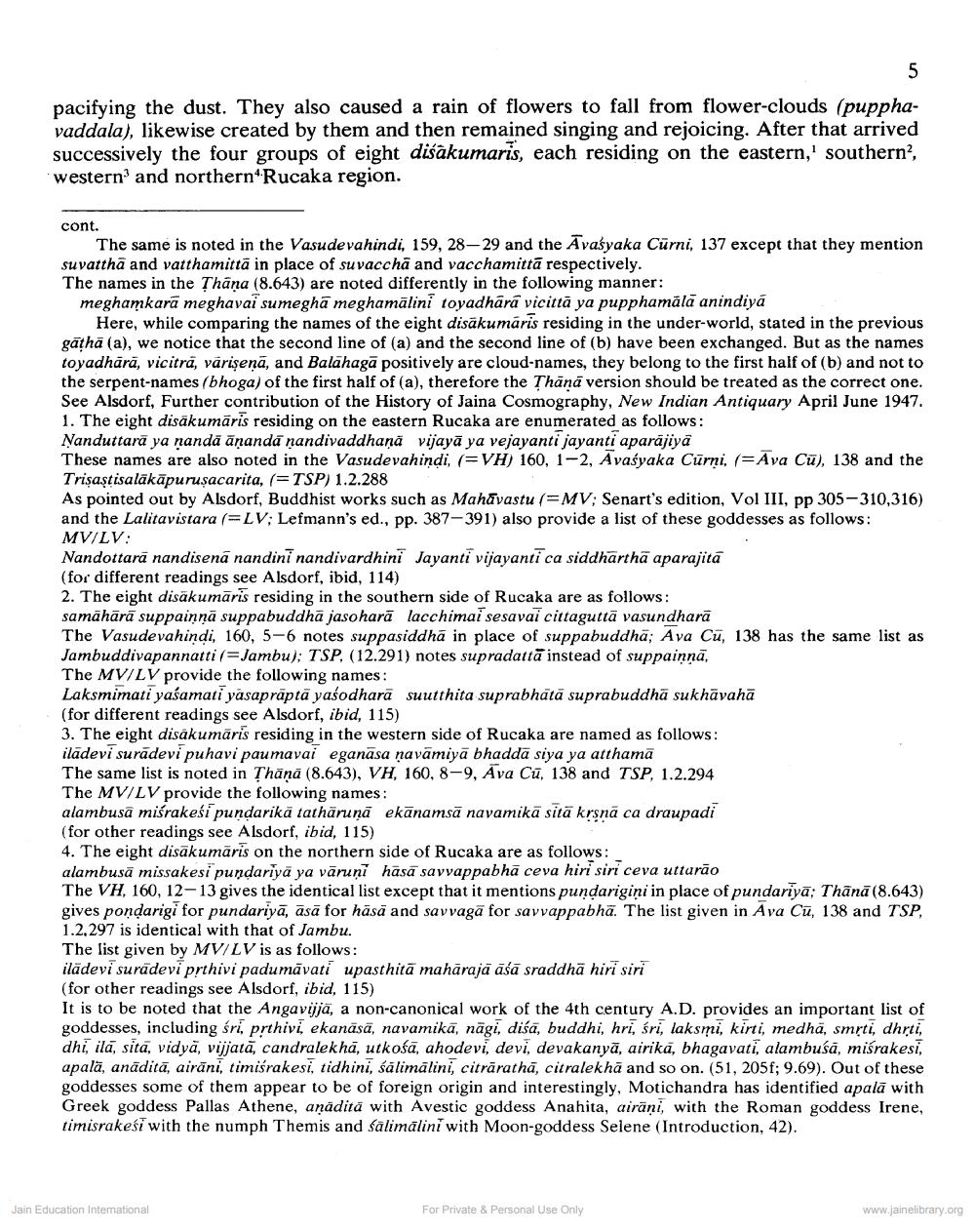________________
pacifying the dust. They also caused a rain of flowers to fall from flower-clouds (pupphavaddala), likewise created by them and then remained singing and rejoicing. After that arrived successively the four groups of eight diśākumaris, each residing on the eastern,' southern?, western and northern“Rucaka region.
cont.
The same is noted in the Vasudevahindi, 159, 28-29 and the Avasyaka Cūrni, 137 except that they mention suvatthā and vatthamitta in place of suvaccha and vacchamittă respectively. The names in the Thana (8.643) are noted differently in the following manner: meghamkarā meghavai sumeghā meghamālini toyadhāra vicittà ya pupphamālā anindiya
Here, while comparing the names of the eight disākumāris residing in the under-world, stated in the previous gāthā (a), we notice that the second line of (a) and the second line of (b) have been exchanged. But as the names toyadhārā, vicitra, värisenä, and Balahagā positively are cloud-names, they belong to the first half of (b) and not to the serpent-names (bhoga) of the first half of (a), therefore the Thānā version should be treated as the correct one. See Alsdorf, Further contribution of the History of Jaina Cosmography, New Indian Antiquary April June 1947. 1. The eight disākumāris residing on the eastern Rucaka are enumerated as follows: Nanduttarā ya nandā āņandā nandivaddhaņā vijayā ya vejayanti jayanti aparājiya These names are also noted in the Vasudevahindi, (=VH) 160, 1-2, Avaśyaka Cürni. (=Ava Cu), 138 and the Trişaştisalākāpuruşacarita, (=TSP) 1.2.288 As pointed out by Alsdorf, Buddhist works such as Mahāvastu (=MV: Senart's edition, Vol III, pp 305-310,316) and the Lalitavistara (=LV; Lefmann's ed., pp. 387-391) also provide a list of these goddesses as follows: MV/LV: Nandottara nandisena nandini nandivardhini Jayanti vijayanti ca siddharthā aparajita (for different readings see Alsdorf, ibid, 114) 2. The eight disakumāris residing in the southern side of Rucaka are as follows: samahārā suppainnā suppabuddha jasoharā lacchimai sesavai cittagutta vasundhara The Vasudevahindi, 160, 5-6 notes suppasiddha in place of suppabuddhā; Ava Cū, 138 has the same list as Jambuddivapannatti (=Jambu); TSP, (12.291) notes supradattā instead of suppainnā, The MV/LV provide the following names: Laksmimati yasamati yasaprāptā yasodharā suutthita suprabhātā suprabuddhā sukhāvahā (for different readings see Alsdorf, ibid, 115) 3. The eight disakumāris residing in the western side of Rucaka are named as follows: ilādevi su rādevi puhavi paumavai eganasa navamiyā bhadda siya ya atthama The same list is noted in Thana (8.643), VH, 160, 8-9, Ava Cu, 138 and TSP, 1.2.294 The MV/LV provide the following names: alambusā misrakesi pundarikā tathārunā ekānamsā navamikā sitā krsnā ca draupadi (for other readings see Alsdorf, ibid, 115) 4. The eight disakumaris on the northern side of Rucaka are as follows: alambusā missakesi pundariya ya vāruņi hasā savvappabhā ceva hiri siri ceva utturāo The VH, 160, 12-13 gives the identical list except that it mentions pundarigini in place of pundariyā; Thānā (8.643) gives pondarigi for pundariyā, āsā for hāsā and savvagā for savvappabhā. The list given in Ava Cū, 138 and TSP, 1.2.297 is identical with that of Jambu. The list given by MV/LV is as follows: ilādevi suradevi prthivi padumā vati upasthitā mahārajā āśā sraddhā hiri siri (for other readings see Alsdorf, ibid, 115) It is to be noted that the Angavijjā, a non-canonical work of the 4th century A.D. provides an important list of goddesses, including sri prthivi, ekanāsā, navamikā, nāgi, diśa, buddhi, hri, sri, laksmi, kirti, medha, smrti, dhrti, dhi, ila, sita, vidyā, vijjatā, candralekha, utkośā, ahodevi, devi, devakanyā, airika, bhagavati, alambusā, misrakesi, apalā, anāditā, airāni, timisrakesi, tidhini, sālimālini, citrarathā, citralekha and so on. (51, 205f; 9.69). Out of these goddesses some of them appear to be of foreign origin and interestingly, Motichandra has identified apalā with Greek goddess Pallas Athene, anädita with Avestic goddess Anahita, airāņi with the Roman goddess Irene, timisrakeši with the numph Themis and sālimālini with Moon-goddess Selene (Introduction, 42).
Jain Education International
For Private & Personal Use Only
www.jainelibrary.org




